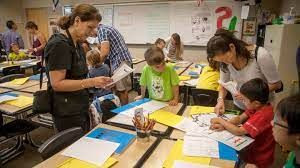The session was initiated by posing a
question: Are you smart? The students according to their experience and prior
knowledge responded to the questions. Initially, they responded to the posed
question while tending towards apparent smartness in the form of dress and
outlook. The facilitator gradually brought them towards multiple intelligences.
Then the formal presentation was delivered using the multimedia projector in order
to give them input on the topic. During the presentation, the students were
involved in the discussion through frequently asked questions. They were provided
with opportunities to share examples regarding each type of intelligence. After
the presentation, a group task was assigned to students to design learning
activities looking at each type of intelligence in each group.
At first, they seemed reluctant to carry out the assigned task. However, the facilitator’s
support in groups made the students get actively involved in the assigned tasks.
They got their heads together to design learning activities on the given type
of intelligence in each group. Active involvement of students was observed in
groups. Some creative ideas were found to be discussed among the students. Upon
completion of the group tasks, students were provided with an opportunity to share
their products work with the whole class.
During group presentations, it was
observed that in each group meaningful and relevant learning activities were
designed by the students. After each presentation, the rest of the students
provided feedback to further improve the designed learning activities. Students
passed valued arguments and challenged each others’ arguments followed by
providing suggestions. At the end of the presentation, the facilitator provided
collective feedback in order to clarify the misconceptions that prevailed among the
students.
From the analysis of the above-mentioned
observation, it can be found that the active involvement of students maximizes
learning in them. At the engaging start of the session, Prior input on the topic and
practice work results in the active involvement of the students leading to
enhanced learning. It is recommended that in professional development courses,
plan the session well, start with posing an engaging question, equip the
participants with relevant content, involve them in practice and application
work and support them so that the set objectives could be achieved.

